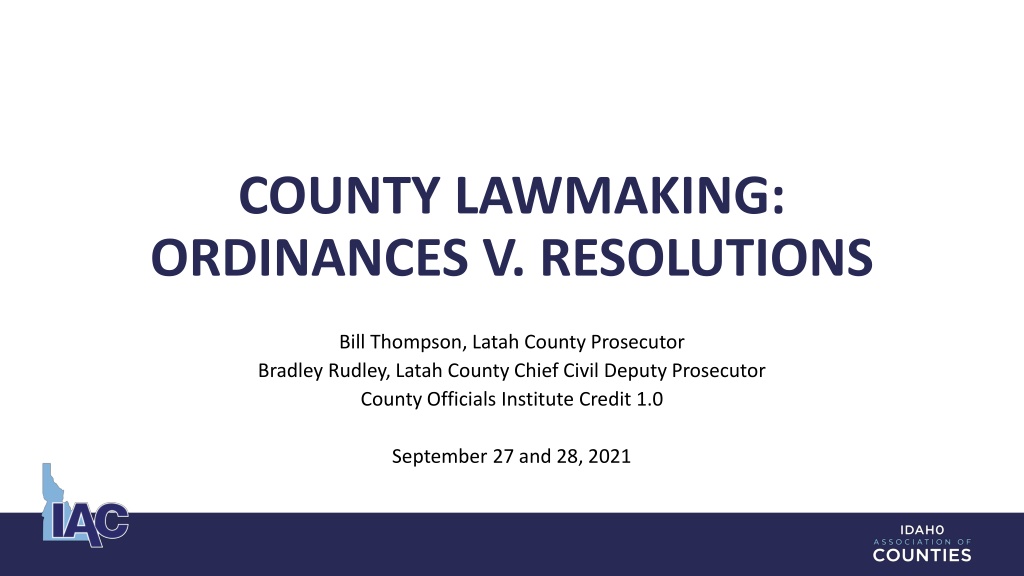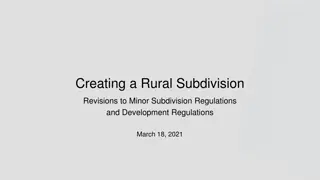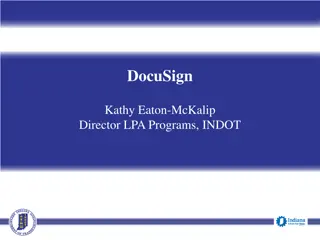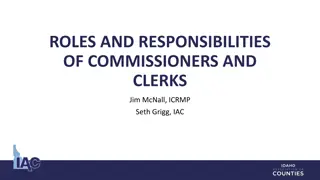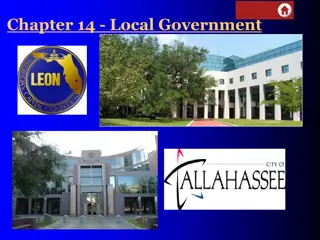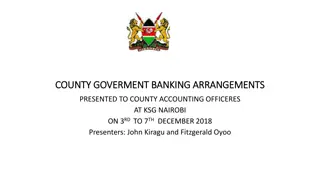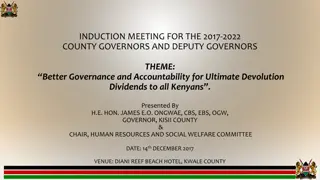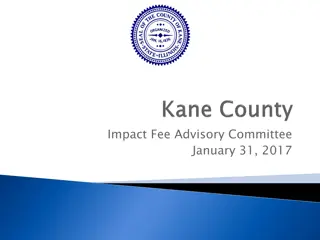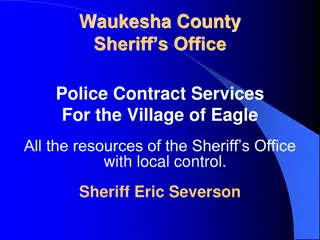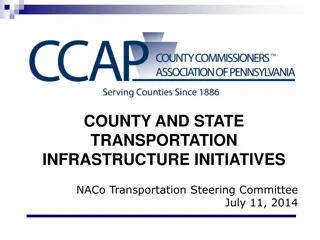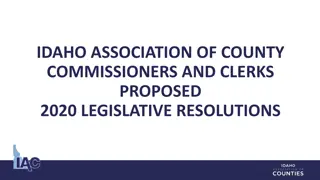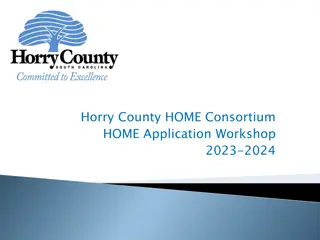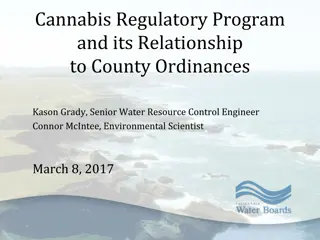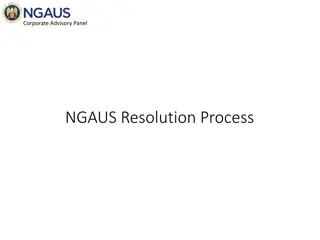Understanding County Lawmaking: Ordinances vs. Resolutions
Explore the differences between ordinances and resolutions, their enforcement, and implications within counties. Learn when each is required or permitted, and receive tips for drafting clear and concise legal documents.
Download Presentation

Please find below an Image/Link to download the presentation.
The content on the website is provided AS IS for your information and personal use only. It may not be sold, licensed, or shared on other websites without obtaining consent from the author. Download presentation by click this link. If you encounter any issues during the download, it is possible that the publisher has removed the file from their server.
E N D
Presentation Transcript
COUNTY LAWMAKING: ORDINANCES V. RESOLUTIONS Bill Thompson, Latah County Prosecutor Bradley Rudley, Latah County Chief Civil Deputy Prosecutor County Officials Institute Credit 1.0 September 27 and 28, 2021
IN DRAFTING ANY ORDINANCE OR RESOLUTION C.Y.A. CONSULT YOUR ATTORNEY
GOALS Avoid making laws like this City of Jacksonville vagrancy ordinance that punished dissolute persons who go about begging, . . . common night walkers, . . . common railers and brawlers, persons wandering or strolling around from place to place without any lawful purpose or object, habitual loafers, . . . persons neglecting all lawful business and habitually spending their time by frequenting houses of ill fame, gaming houses, or places where alcoholic beverages are sold or served, persons able to work but habitually living upon the earnings of their wives or minor children . . .
Learn: The differences between Ordinances and Resolutions; Examples of where each is required or permitted; and Tips for drafting clear and concise ordinances and resolutions. GOALS
WHAT IS AN ORDINANCE? Laws of the County: Have force and effect of law. Can be enforceable up to a misdemeanor crime. Encompass rules and regulations which public must be aware of. Only enforceable within unincorporated areas of the County.
ARTICLE XII, SECTION 2 OF ARTICLE XII, SECTION 2 OF IDAHO CONSTITUTION IDAHO CONSTITUTION Any county or incorporated city or town may make and enforce, within its limits, all such local police, sanitary and other regulations as are not in conflict with its charter or with the general laws.
ORDINANCES - IDAHO CODE 31-714 The board of county commissioners may pass all ordinances and rules and make all regulations: - not repugnant to law, - necessary for carrying into effect or discharging the powers and duties conferred by the laws of the state of Idaho, - and such as are necessary or proper to provide for the safety, promote the health and prosperity, improve the morals, peace and good order, comfort and convenience of the county and the inhabitants thereof, and for the protection of property therein . . .
ORDINANCES - IDAHO CODE 31-714 County may enforce obedience to ordinances with such fines or penalties, including infraction penalties, as the board may deem proper; provided, that the punishment of any offense shall be by fine of not more than one thousand dollars ($1,000) or by imprisonment not to exceed six (6) months, or by both such fine and imprisonment.
ORDINANCES REQUIRED FOR: Rules and regulations for the operation and maintenance of solid waste disposal systems. I.C. 31-4406. Adopting a zoning ordinance or building code. I.C. 39-4116 and 67-6511. Declaring an emergency or imposing a moratorium under LLUPA. I.C. 67- 6523. Adopting an area of city impact. I.C. 67-6526. Establishing a minimum investment amount for receiving the plant investment property tax exemption. I.C. 63-602NN. Refunding property taxes which should not have been paid due to error of the county. I.C. 63-1302. Starting process to create taxing districts, governing boards, etc.
When authorized by constitution or statutes Management and rules in county parks ORDINANCES Dogs/Animals Noise Large gatherings PERMITTED USES: Alcoholic beverage licenses Addressing Minors Noxious weeds
When you lack statutory or constitutional authority. ORDINANCES When lawmaking in an area preempted by State or Federal law: State preemption: Firearms Herd Districts Federal preemption: Cell phone towers Clean Water Act ADA Constitutional preemption: Civil Rights (speech, religion, voting rights) Unlawful discrimination WHEN PROHIBITED:
CONTENTS OF AN ORDINANCE TEMPLATE Must include: "Be it ordained by the board of county commissioners of . county, Idaho. Idaho Code 31-715.
CONTENTS OF AN ORDINANCE TEMPLATE - Purpose - Definitions - Key provisions (license/permit requirements, punishable conduct, etc.) - Notice and due process - Violations and penalties - Repeal/Amendment of prior ordinances - Severability - Effective Date
MAKING YOUR ORDINANCE EFFECTIVE - Effective after ordinance is published in newspaper. Must publish within one month of passing ordinance. - Can publish a summary. Summary must include: - (a) The name of the county; - (b) The formal identification or citation number of the ordinance; - (c) A descriptive title; - (d) A summary of the principal provisions of the ordinance, including penalties provided and the effective date; - (e) Any other information necessary to provide an accurate summary; and - (f) A statement that the full text is available and the name, location, and office hours of the agency where a complete copy may be obtained. Idaho Code 31-715 and 31-715A.
CLERK CERTIFICATION OF SUMMARY CLERK CERTIFICATION OF SUMMARY
KEY CONSIDERATIONS IN LEGISLATIVE DRAFTING BEFORE DRAFTING PROCESS Is this an allowable power of the county? Am I legislating in an area preempted by state or federal law? Does it conflict with another ordinance? Engage other stakeholders or staff.
KEY CONSIDERATIONS IN LEGISLATIVE DRAFTING WHILE DRAFTING Harvard Law School Guide to Legislative Drafting: - Write simply and carefully; - Write purposefully; - Do your research efficiently; - Do not rush to recreate the wheel; - Don t be afraid to ask questions, both substantively and stylistically; - Keep in mind the bigger picture and your role in the process; - Masterful legislation requires teamwork; and - Be patient. https://harvardjol.com/2016/10/24/a-beginners-guide-to-legislative- drafting/#_ftnref2
KEY CONSIDERATIONS IN LEGISLATIVE DRAFTING WHILE DRAFTING - Who is your audience? - Use clear, plain and simple language. - https://www.plainlanguage.gov/ - Clearly organize your sections. - Put rules before exceptions. - Put the broadly applicable before the narrowly applicable.
KEY CONSIDERATIONS IN LEGISLATIVE DRAFTING AFTER DRAFTING The only kind of writing is rewriting. Ernest Hemingway. Have others review it.
LEGAL ASPECTS OF LAWMAKING Does your law infringe a constitutionally protected activity? Freedom of speech; Freedom of religion; Freedom of assembly. Canons of Statutory Interpretation: Starts and, hopefully, ends with Plain Meaning. Canons for penal statutes.
WHAT IS A RESOLUTION? Robert s Rules of Order on Resolutions More formal motion & order More elaborate & formally written Or motion of a longer nature Usually directing an action by a county office, the Board, or setting a policy or position.
WHEN IS A RESOLUTION REQUIRED? Disaster declarations (I.C. 46-1011). Promulgating rules and procedures for non-medical indigent assistance (I.C. 31- 3401). Destroying County records (I.C. 31-871). Adopting the budget (I.C. 31-1605). Transferring county funds which were put in separate fund and are now inoperative (I.C. 31-1508). Sole source procurement (I.C. 67-2808). Declaring an odd lot property or transferring property to another political subdivision (I.C. 31-808). Forming a county hospital board (I.C. 31-3601). Waiving a local magistrate judge (I.C. 31-879). Allowing the sale of liquor on Sundays (I.C. 23-308).
Setting county fees (I.C. 31-870 and 63-1311). WHEN CAN YOU USE A RESOLUTION? Declaring a special day/month. Establishing more formal county policies or positions. As authorized by your ordinances.
Explain reasoning for the resolution in the Whereas section HOW TO WRITE A RESOLUTION Provide language on the clear action or position being taken or directed in the Resolved
ORDINANCE OR RESOLUTION? 1. Establishing rules for the parking lots at your county facilities. 2. Creating a GIS System database, user fees and intellectual property protections. 3. Adopting meeting bylaws for the Board of Commissioners. 4. Setting rules for the use of burglary and robbery alarms. 5. Approving a policy for insufficient funds checks. 6. Forming the county Arts and Culture committee.
QUESTIONS Latah County Prosecutor s Office 208-883-2246 pa@latah.id.us
